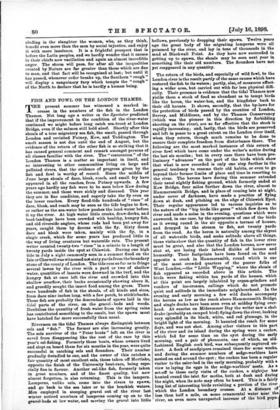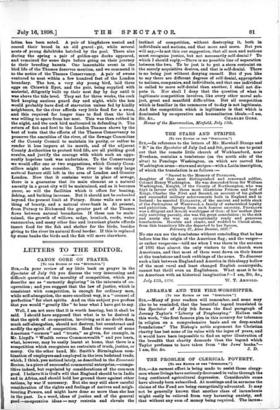FISH AND FOWL ON THE LONDON THAMES.
THE present summer has witnessed a marked in- crease in the numbers of the fish in the London Thames. Not long ago a writer in the Spectator predicted
that if the improvement in the condition of the river-water continued we might before long catch sea-trout at London Bridge, even if the salmon still held aloof. Shortly after this shoals of a true migratory sea fish, the smelt, passed through London and revisited Putney, Kew, and Teddington. The smelt season is not due until the end of August, but the evidence of the return of the other fish is so striking that it has caused general comment and remark amongst persons of all classes familiar with the river. The " restoration" of the London Thames is a matter so important in itself, and so interesting to other communities living on large and polluted rivers, that the evidence of progress given by the fish and fowl is worthy of record. Since the middle of June large shoals of dace, bleak, roach, and small fry have
appeared in all the reaches, from Putney upwards. A few years ago hardly any fish were to be seen below Kew during the summer, and these were sickly and diseased. This year they are in fine condition, and eagerly take the fly even on the lower reaches. Every flood-tide hundreds of " rises " of dace, bleak, and roach may be seen as the tide begins to flow, or rather as the sea-water below pushes the land-water before it up the river. At high water little creeks, draw-docks, and boat-landings have been crowded with healthy, hungry fish, and old riverside anglers, whose rods had been put away for years, caught them by dozens with the fly. Sixty dozen dace and bleak were taken, mainly with the fly, in a single creek, which for some years has produced little in the way of living creatures but waterside rats. The present writer counted twenty-two " rises " in a minute in a length of twenty yards inside the eyot at Chiswick. During one high tide in July a sight commonly seen in a summer flood on the Isis or Cherwell was witnessed not sixty yards from the boundary stone of the county of London. The tide rose so far as to fringe several lawns by the river with a yard or two of shallow water, quantities of insects were drowned in the turf, and the hungry fish at once left the river and crowded into this shallow overflow, their backs occasionally showing above it, and greedily sought the insect food among the grass. There were hundreds of fish in the shoals, of all kinds and sizes, from dace nine inches long, with a few perch, to sticklebacks. These fish are probably the descendants of spawn laid in the tidal parte of the river, on the gravel - beds and weeds. Doubtless the quantity of fresh water from the spring rains has contributed something to the result, but the spawn must have hatched far more successfully than usual.
Rivermen on the tidal Thames always distinguish between eels and " fish." The former are also increasing greatly. The sole survivor of the "Peter boats" left on the river is saved from disappearing like the rest of the race by this year's eel-fishing. Formerly these boats, whose owners lived and slept on board them for six months in the year, were quite successful in catching eels and flounders. Their number gradually dwindled to one, and the owner of this catches a fair quantity of most excellent eels, those taken off Mortlake, opposite the finish of the University boat-race, being espe- cially fine in flavour. Another eel-like fish, formerly taken in great numbers, and of the finest quality, but now almost forgotten, is also returning. This is the lampern. Lamperns, unlike eels, come into the rivers to spawn, and go back to the sea later or to the brackish waters. Men employed in scooping gravel out of the river last winter noticed numbers of lamperns coming up on to the gravel-beds at low water, and movina the gravel into little hollows, previously to dropping their spawn. Twelve years ago the great body of the migrating lamperns were all poisoned by the river, and lay in tens of thousands in the mud at Blackwall Point. As they have now succeeded in getting up to spawn, the shoals may be seen next year in something like their old numbers. The flounders have not yet reappeared in any quantity.
The return of the birds, and especially of wild fowl, to the London river is the result partly of the same causes which have restored the fish to its waters; partly, also, of measures affect- ing a wider area, but carried out with far less physical diffi- culty. Their presence is evidence that the tidal Thames now yields them a stock of food so abundant as to tempt birds like the heron, the water-hen, and the kingfisher back to their old haunts. It shows, secondly, that the by-laws for the protection of birds passed by the counties of London, Surrey, and Middlesex, and by the Thames Conservancy (which was the pioneer in this direction by forbidding shooting on the river), are so far effective that the stock is rapidly increasing ; and, lastly, that the birds are preserved and left in peace to a great extent on the London river itself, when they return, though much remains to be done to ensure their complete freedom from disturbance there. The following are the most marked instances of this return of river fowl which have come under the writer's notice during the last six months ; but in every case there have been pre- liminary "advances" on the part of the birds which show that what is now recorded is only one step further in the general tendency to resume their old habits, or even to go beyond their former limits of place and time in resorting to the river. The herons have daring this summer extended their usual nightly fishing ground, which formerly ended at Kew Bridge, four miles further down the river, almost to Hammersmith Bridge, and in place of coming late at night, under cover of darkness, have made a practice of flying down at dusk, and pitching on the edge of Chiswick Eyot. Their regular appearance led to various inquiries as to the nature of the " big birds like geese " which flew down the river and made a noise in the evening, questions which were answered, in one case, by the appearance of one of the birds as it swung round in the air opposite a terrace of houses, and dropped in the stream to fish, not twenty yards from the road. As the heron is naturally among the shyest of all waterside birds, and seeks solitude above all things, these visits show that the quantity of fish in the lower river I must be great, and also that the London herons, now never shot at, are losing their inbred dislike of houses and humanity. Their footprints have been found on the mud opposite a creek in Hammersmith, round which is one of the most crowded quarters of the poorer folks of West London,—the " Little Wapping," where the shoals of fish appeared as recorded above in this article. The birds were fishing within ten yards of the houses, which at this point are largely inhabited by organ-grinders and vendors of ice-creams, callings which do not promote quiet and solitude in the immediate neighbourhood. In the evening and early morning a few wild ducks accompany the herons as low as the reach above Hammersmith Bridge, and single ducks have been seen even at midday flying over- head. At sunrise on Midsummer Day the writer saw a shel- drake (probably an escaped bird) flying down the river, looking very splendid in its black, white, and red plumage, in the bright light of the morning. It haunted the reach for some days, and was not shot. Among other visitors to this part of the river and its island during the spring were a curlew, which fed for some time on the eyot during the early morning, and a pair of pheasants, one of which, an old- fashioned English cock bird, was subsequently captured un- hurt. A flock of sandpipers remained there for some weeks, and during the summer numbers of sedge-warblers have nested on and around the eyot ; the cuckoo has been a regular visitor to the osier-bed in the early morning, probably with a view to laying its eggs in the sedge-warblers' nests. As a set-off to these early visits of the cuckoo, a nightjar has hunted round the islet for moths, both at dusk and during the night, when its note may often be heard. This is a fairly long list of interesting birds revisiting a portion of the river which the London boundary crosses. At a distance of , less than half a mile, on some ornamental water near the river, an even more unexpected increase of the bird popu-
lation has been noted. A pair of kingfishers nested and reared their brood in an old gravel - pit, while several nests of ycung dabchicks hatched by the pool. There also during the spring a pair of golden-eye ducks appeared, and remained for some days before going on their journey to their breeding haunts. One lamentable event in the bird life of the Thames deserves mention, and we commend it to the notice of the Thames Conservancy. A pair of swans ventured to nest within a few hundred feet of the London boundary. The hen, a very shy young bird, laid three eggs on Chiswick Eyot, and the pair, being supplied with material, diligently built up their nest day by day until it was above the tide level. They eat for three weeks, the cock bird keeping anxious guard day and night, while the hen would probably have died of starvation unless fed by kindly neighbours, for the river affords very little food for a swan, and this required far longer time to find than the bird was willing to spare from her nest. This was then robbed in the night, and the cock bird maltreated in defending it. The return of fish and fowl to the London Thames shows by the best of tests that the efforts of the Thames Conservancy to preserve the amenities of the river, of the Sewage Committee of the County Council to maintain its purity, or rather to render it less impure at its month, and of the adjacent County Authorities to protect bird life, are all yielding good results, and justify the courage with which such an appa- rently hopeless task was undertaken. To the Conservancy we would offer one or two suggestions, which County Coun- cillors might also consider. The river is the only large natural feature still left in the area of London and Greater London. Now that it contains water in place of sewage, there is a guarantee that its main element as a natural amenity in a great city will be maintained, and as it becomes purer, so will the facilities which it offers for boating, fishing, and bathing increase. But it should not be embanked beyond the present limit at Putney. Stone walls are not a thing of beauty, and a natural river-bank is. At present, from Putney to Richmond the greater part of the Thames flows between natural boundaries. If these can be main- tained, the growth of willows, sedge, hemlock, reeds, water ranunculus, and many other fine and luxuriant plants affords 'insect food for the fish and shelter for the birds, besides giving to the river its natural floral border. If this is replaced Eby stone banks the birds and the fish will move elsewhere.



































 Previous page
Previous page